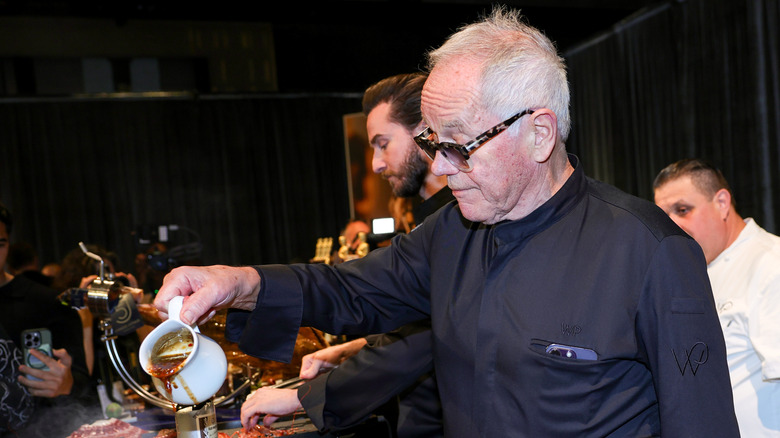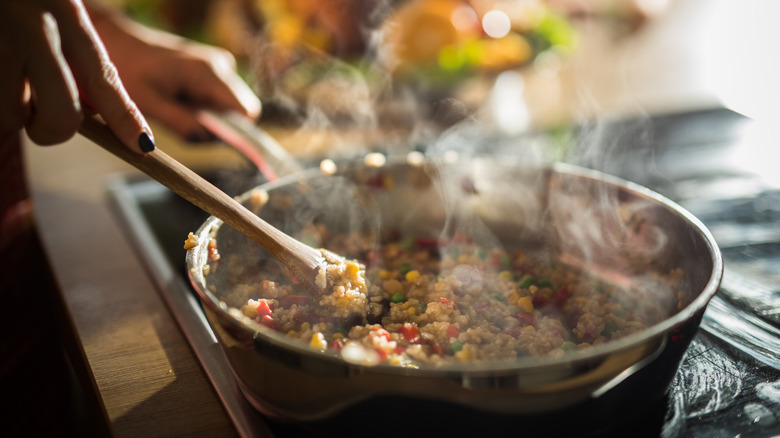Why Wolfgang Puck Heavily Seasons Cold Food
It should come as no surprise that a chef with as much experience and world renown as Wolfgang Puck knows a thing or two about how to properly season food. Puck not only owns more than 20 restaurants (including the famous Spago), but he is also a seven-time James Beard award winner (and played a significant role in defining one of America's regional pizza styles). Clearly, he knows how to properly season a dish. But why exactly is it that Puck — and other skilled chefs — add more seasoning to foods served cold? As it turns out, when we eat cold foods, we actually taste them less.
That's right, when your tongue is cold, as from eating cold foods, it is less capable of perceiving those five major flavors: salty, sweet, sour, bitter, and umami. In order for a cold dish to be perceived with the same piquancy as a warm counterpart, a practiced chef knows they must increase the seasoning. This means that a vinaigrette for a chilled salad needs more acid, a cold soup requires additional salt, and dark chocolate ice cream must lean more bitter.
Surprisingly, perhaps, this is also true for very hot foods. There is something of a "Goldilocks zone" for flavor perception at what is generally considered to be lukewarm. Fortunately, it is easy to serve and eat food at a lukewarm temperature. It is warm, but not steaming — seemingly fresh from the kitchen, but without the risk of burning oneself. Though to truly understand why it is that our perceptions of flavor change with temperature, we need to delve deeper into the science of flavor.
How does temperature affect taste?
As mentioned above, the human tongue best perceives flavors at temperatures that we might consider to be lukewarm. A 2006 study from KU Leuven in Belgium pinpointed this window at 68 to 86 degrees Fahrenheit. This range was the center of the U-shaped bell curve, with flavor perception tapering off as temperatures either increased or decreased away from this window.
Now, this doesn't necessarily mean that we ought to be serving all our foods lukewarm — only that we need to consider temperature when it comes to seasoning. As an example of the changing perceptions of flavor with temperature, the Belgian study mentions two experiences that you may have experienced yourself: the cloying sweetness of melted ice cream and the intense bitterness of warm beer. Both of these foodstuffs are wonderful exactly as they are — few would argue that either beer or ice cream needs to be changed — but they are generally intended to be served nice and cold. So, really, we can all simply say thanks to the invention of refrigeration for allowing us to consistently enjoy cold beer and cold ice cream.
While there are numerous studies focused on the tongue's perception of taste at varying temperatures, the tongue can only experience the five major flavors, which actually encompass a relatively small portion of the overall flavor experience. When you eat a good meal, you probably experience some component of all five flavors, but much of what you perceive as taste actually comes from the aroma.
Is aroma also affected by temperature?
When you think of the unique taste of strawberries, it is immediately clear that this is about more than just the big five. Sure, strawberries always have elements of sweet and sour, but these vary widely based on how ripe an individual fruit is. What makes strawberries unique is the aroma. Whether it is a deep red berry, ripe to the point of squishiness, or an early-season fruit, still tart and firm, they both taste (or, really, smell) like a strawberry.
There are not as many studies around the relationship between temperature and aroma, though this is likely because it has more to do with physics than our sensory organs. When a substance is heated, it releases volatile chemicals, which are what give it a smell. This is true in the kitchen as well as outside of it, and you already have sensory experiences to match this claim. Think back to the last time you made chocolate chip cookies, the whole house filling with that nostalgic smell of baked goods. That was the result of aromas being released by heat. So, while we may not have a similar "Goldilocks zone" for the perception of aroma, its relationship with temperature is readily apparent.
Clearly, some foods are best eaten cold, and others just need an extra spike of seasoning to reach their full potential. We know the ideal temperature for maximum flavor, while aroma is not so easily defined. But a bit more knowledge on the science of how we perceive flavor is always a good thing to have in your toolkit.


